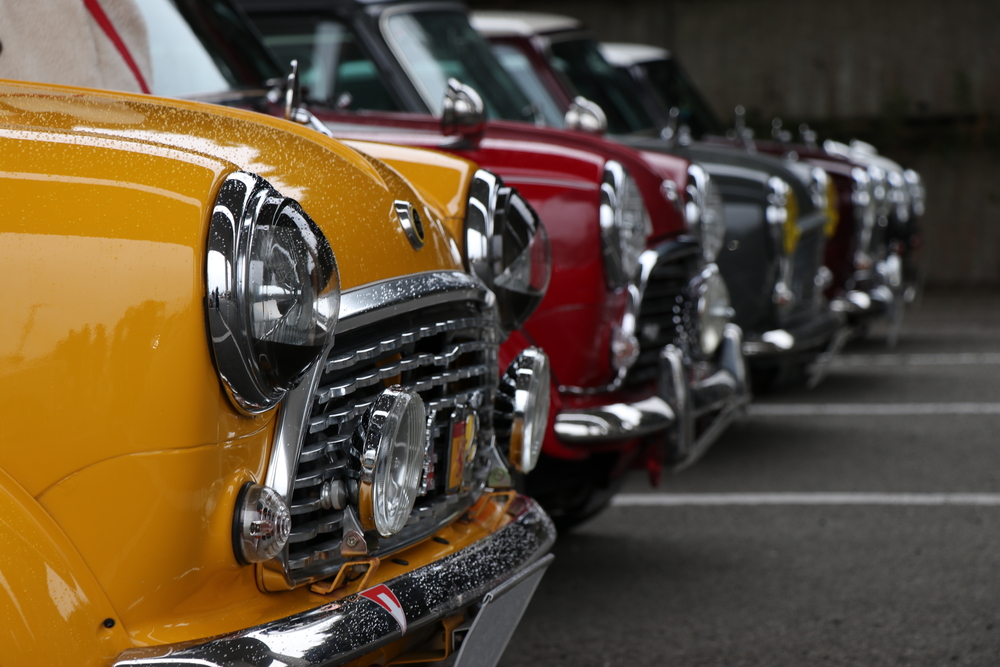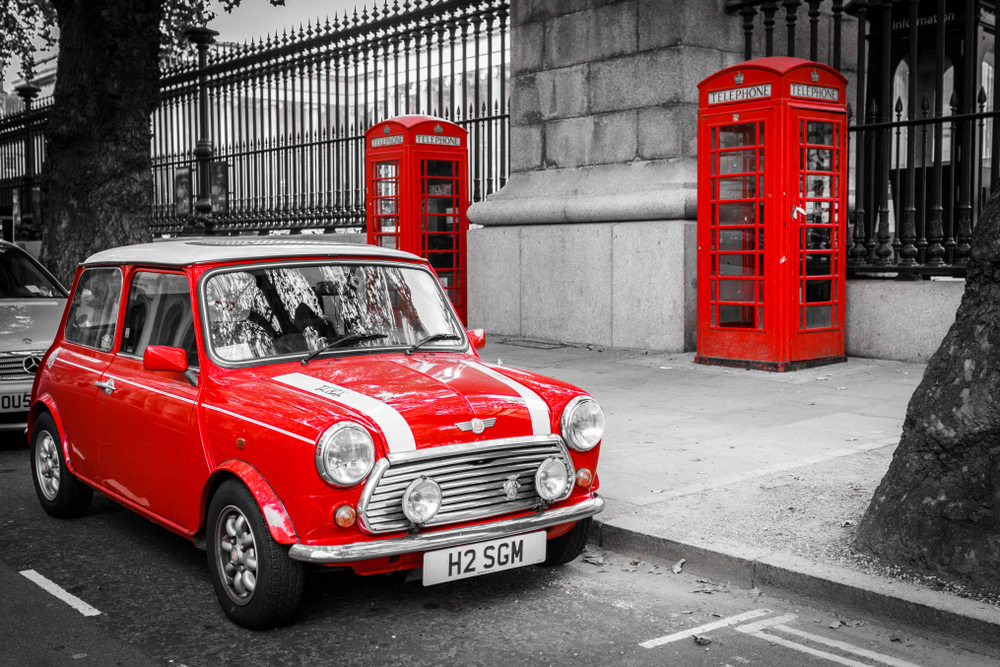The luxury of Rolls-Royce, the speed of McLaren, and the symbolic nature of James Bond and his trusty Aston Martin are just a few car brands that jump out at you when you think about British motoring icons. But one name has a history and timelessness that makes it one of the biggest British icons of all… the classic Mini.
In this article, we delve into the amazing story and history of the classic Mini, looking at how it evolved into being one of the world’s most iconic vehicles.
The Origin and Development of the Classic Mini by Sir Alex Issigonis
Elevating the Mini to British classic status was a long process that started post-World War II in a UK that was still feeling the economic effects of war.
The biggest challenges facing the country were cost, recession, and rationing. Were the bigger, fuel-hungry cars of the previous decades still worth producing? The challenge was to design and build a smaller, cheaper, fuel-efficient car capable of carrying four people.
In steps Sir Alec Issigonis, a top engineer at the Morris Motors company who spent two years from 1957-1959 crafting the perfect motoring solution that would go on to revolutionise the car industry forever.
The icon of the Swinging Sixties was new and stylish, and it attracted attention from all ages of drivers seeking a reliable, smaller car. The Mini was something of cultural crusader as its popularity overcame Britain’s social barriers, with everyone from royalty to hipsters sharing the same love for the motoring phenomenon.
What Made the Mini Design So Special?
When the Mini was launched in 1959 it turned heads immediately. Its compact features were specifically designed to allow for more space inside. For example, Issigonis moved the wheels right into the corner of the vehicle and turned the engine sideways to allow for extra room in the cockpit for the four passengers.
Furthermore, what made this design so impressive and revolutionary was that it also created a more stable driving experience, which made the fun-size Mini a more efficient and safe alternative to the cars of the time, not to mention more affordable.

Perhaps the most important aspect of the car’s origin is what it did for Britain and the motor industry as a whole. Fuel shortages at the time saw a desperate need for more efficient and economical vehicles. Suddenly, the Mini was born and has since gone on to become the best-selling British car in history, with over 5.1 million models sold globally as of 2021.
Who Designed the Classic Mini?
It would not be a Mini-focused article without mentioning the man behind the creation of this motoring legend. Sir Alec Issigonis was a British automobile designer who first worked for Morris Motors in 1936 as a suspension designer. During this time, he developed the Morris Minor, which remained in production from 1948 until 1971.
After briefly working elsewhere during the 1950’s, Issigonis returned to what became the British Motor Corp. There, he went on to develop the Mini in 1959, not only as a response to the Suez Crisis, but also to combat the popularity of the Volkswagen Beetle.
The compact but comfortable design was a radical change from other cars in the market at the time and offered the practicality and affordability that many Britons were searching for. The design and innovation of the Mini remains one of the biggest and most revolutionary changes in motoring history.
How the Classic Mini Became a Racing Legend
‘Racing legend’ isn’t the first thing you think of regarding the Mini. But when legendary racing constructor and owner of Cooper Car Company, John Cooper, stepped on board, the humble little car built for efficiency took the racing world by storm.
With a small, low-to-the-ground stature and terrific handling capability that the Mini possessed gave it huge potential that John Cooper was determined to unlock. So, with a more powerful engine, better brakes, and some racing tuning, the Classic Mini Cooper was ready to rally.
Despite being built for everyday motoring by Issigonis and his reluctance to collaborate with Cooper, the potential was recognised only a year later in 1962 when female racing driver Pat Moss stepped into the car to take home first place and Mini’s first international rally victory at the Tulip Rally in Monte Carlo.
After that win, Mini solidified themselves as a force to be reckoned with, as they went on to historic wins at the Monte Carlo Rally in 1964, 1965 and 1967. MINI and John Cooper had developed the classic Mini into a winner that continuously proved to be superior to its competitors.
And if that isn’t convincing enough to show its racing pedigree, founder of one of the world’s biggest and most heralded car and racing brands to ever exist, Enzo Ferrari, owned a Mini. His passion for racing led him to appreciate the revolutionary engineering of the British classic. So even the man with every Ferrari at his disposal drove around in a humble Mini.
Mini as an Icon in Popular Culture
Throughout the decades and various changes and iterations of the Mini, there has remained a unique spirit behind the car that keeps it committed to its roots and the humble beginnings that saw it dominate the motor industry.
As the brand grew and the Mini name became famous around the world, its status as an icon of Britain was solidified. It was firmly established in popular culture and became a truly iconic motoring symbol, featuring heavily in TV adverts and popular movies alike.
The Italian Job
One of the best examples of a car being attached to popular culture, the Mini was the go-to choice for Michael Caine when he needed a high-performing car that could navigate Italy’s tight city streets at fast speeds.
Used again for the modern remake, the colourful collection of Minis added both style and excitement to the films. It’s even safe to say that many people recognise the Mini as the defining symbol of the Italian Job films, despite Caine’s memorable acting performance.
Mr Bean
The vibrant yellow classic Mini was the perfect match for the hapless comedy character of Rowan Atkinson’s Mr Bean. However, did you know that Mr Bean has had more than one Mini, and that the first one was orange?
Nevertheless, both in TV and film, animation and live action, the pair enjoyed years of memorable moments and unforgettable adventures that reinforce the Mini as a classic symbol of British culture.
The Evolution of the Modern Mini
All industries evolve, and that is also true of the motoring sector. The classic Mini has seen numerous revamps and new models, and even a takeover from German manufacturer BMW.
But even with all that’s happened to the Mini brand, they have maintained the same culture and loyal following. The slogan ‘There’s a Mini for Everyone’ still applies to this day. BMW took that ideology into the modern era to produce Minis of all shapes and sizes such as the 3-door, convertible, or larger countryman model.
Looking further ahead, Mini wants to hark back to its origins by becoming a motoring pioneer once again. Moving towards a more sustainable era that looks to make a positive impression on climate change and emissions, the Mini Electric range was launched in 2020 and became the latest addition to the brand’s line of vehicles.
The Mini Electric represents the future of the car industry and promotes the same exciting future that Sir Alec Issigonis wanted to create, one of engineering excellence and improved automotive efficiency.
The classic Mini is undoubtedly an iconic symbol in British culture and sits high up on the list of triumphant achievements in the motoring industry. From the humble beginnings of the compact and revolutionary design created by Sir Alec Issigonis to the colourful motoring co-star in The Italian Job, and now moving into a sustainable future with their electric models, from the moment they were created – Mini were and continues to be a pioneer in the car industry.
Do You Have a Classic Mini and are Looking for Classic Car Insurance?
If you’re looking for classic car insurance, the team of experts at Keith Michaels would be happy to provide further information to help you protect your unique and treasured vehicle. Contact our team today to receive a quote.


